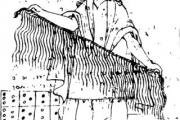Viewings: 6667

Long time was considered that one of the greatest ancient civilizations - Inca Empire was "only" a civilization of the bronze age, who knew no script. But last summer was published the book Harvard Professor Gary Urthona "Signs of the Incan pile, which suggests that the Incas writing all the same there was, however, special, disguised as a colored rope, tied in knots. We are talking about nodular letter stack (in Quechua, the language of the Incas - "quipu" means "site"). After Ortona more and more scientists are inclined to think that with a pile of things are not so simple...
...The end of the XVI century In the conquered lands of South America hosted the Spanish conquistadors. Once on the road three Spaniards, hastening Affairs, appeared the old Indian. Judging by the clothes that he was a representative of the local nobility. Seeing strangers, Indian tried to hide something in the folds of the clothing. But conquistadors had noticed his attempt and, no doubt, snatched it from him what he tried to protect them from prying eyes. To the surprise of the Spaniards, they were a bunch of colored rope with knots. Conquistadors, exchanged looks with astonishment, asked the Indian what it is. Inka, seeing that he has nothing to do with dignity replied, "all things written down Here conquerors - both bad and good". Did not like this answer to the Spaniards. It was decided Indian severely punish the insolence and "dirt" - a mysterious nodules - just in case to destroy. That was the beginning of the widespread confiscation and destruction of unique cultural monuments of a great civilization - samples nodular letters of the Incas.
The Spaniards declared a stack object of pagan worship, though they were sure that they contain important information. But attempts to decrypt it to nothing lead. The most prominent experts on cryptography unsuccessfully fought over the knots... But have the Incas were special people - gipokaliemii (keepers of the stack), which could obtain necessary information, with incredible speed running his fingers through nodules. But they unbreakable kept their secrets.
Then came among Europeans legend, which stated that a stack is nothing like the curse of the invaders created ingenious by the Incas in revenge for the ruined country... Gradually it all was quiet on that pile is only a decorative element of the service. In an extreme case - a primitive system of accounts ("knots on memory").
Indian with a stack. Engraving of the XVI century
The beginning of systematic studying stack only began in 1923, when knots interested historian Leland Locke. He completely rejected the notion decorative pile. But Locke considered nodular letter only as a transfer method of mathematical data, and it took several decades to change that. Now, many scientists believe that colored nodules Inca gradually developed into a complex system of three-dimensional writing (like Braille).
Today in museums and private collections is only 600 miraculously preserved specimens of the ancient pile. Archaeologist Cornell University Robert Ascher believes that about 20% of them are not numeric. Back in 1981, it was suggested that a stack is a special form of writing. According to scientists, the stack contains about one and a half thousand units of information - individual characters. That is, slightly more than in Sumero-Babylonian cuneiform, and almost twice more than in Egyptian hieroglyphics or the Mayan hieroglyphs. Mathematics has determined that when you create a stack Incas used the binary encoding, like the one that underlies the modern computer languages. Did the representatives of ancient civilization has created a rope computer?! Scientists also believe that if a stack is really a form of writing, it will not transmit plain speaking, and is something of a musical notation, or the same computer code.
The already mentioned Gary Urton in his book says that at least a dozen ancient documents relating to the history of the Incas, translated into written language from the pile. The only snag is that anyone so far failed to define what documents with which pile translated.
The deciphering of the pile would have given scientists a truly unique opportunity for a detailed study of the history and culture of the Inca Empire, remains today one of the most mysterious civilizations. So attempts to decrypt nodular letter does not stop. She is working on a book on the stack, Galen Brokaw - worker of the Department of romance languages and literature at the College of arts and Sciences at the University at Buffalo. Based on the findings of Urthona, Brokaw took the view that the first step to understanding quipu the comparison must be preserved examples pile with the Incan Chronicles. The book, in which Brokaw explores the famous chronicle of Guaman Poma, which, he believes, was transferred from the pile, promises to be a real sensation.
















